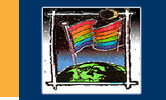Memoirs — Gens Hellquist
The Adventures of a Prairie Fag
Perceptions, The Gay & Lesbian Newsmagazine of the Prairies
Vol. 19, issue # 2, March 14, 2001.
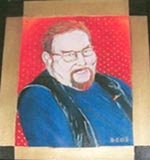 March
2001 marks the 30th anniversary of the beginning of efforts to build a gay and lesbian community in Saskatoon. While there were small groups
of gay men and other small groups of gay women going back at least to the 1920s, there were no organized initiatives to address the issues
that affected gay people until the first formal queer organization was begun in March 1971.
March
2001 marks the 30th anniversary of the beginning of efforts to build a gay and lesbian community in Saskatoon. While there were small groups
of gay men and other small groups of gay women going back at least to the 1920s, there were no organized initiatives to address the issues
that affected gay people until the first formal queer organization was begun in March 1971.
It's important for us to be aware of where we have come from and how we got to where we are today. The lessons of the past can help guide
our actions in the present and future. I have been part of the identified gay and lesbian community since I came out in 1965 at the tender
age of 19 and have been involved in establishing organizations and services in the queer community since I helped found the first queer group
in Saskatoon in 1971. This is also my 30th anniversary as a queer activist.
It has been a fascinating journey with times of sheer exhilaration and times of deep despair. I have had the honour and privilege to meet
and work with hundreds of wonderful men and women, gay and non-gay, who have toiled to build a place where all queer people are valued and
cherished.
This four-part series is a brief overview of my perceptions of Saskatoon's queer community. It is told through my eyes and others will have
somewhat different stories to tell; stories seen through their eyes. However one sees the events and issues, we all have shared in the passions
of carving out safe places for ourselves and our queer family.
Part 2
By early 1971 queer issues had began to bubble to the surface. Two years earlier Pierre Trudeau, then Justice Minister, had amended the Criminal
Code to decriminalize anal and oral intercourse, although being illegal had never stopped us. Word of the Stonewall Riots had slower seeped
into Canada and onto the prairies. We had come through a decade of marches calling for equality for blacks and women. We began to question
why we also shouldn't have equality.
The Georgia Straight listing for Saskatoon Gay Liberation appeared in the April 1971 issue and slowly responses trickled in. One of the
first letters was from a lesbian, so we arranged a meeting. Neither Dan or myself knew any lesbians in Saskatoon so we were excited about finally
meeting one locally. We met her at Dan's house and the first thing she told us was that the name she had signed the letter with was false and
that her real name was Mavis Carleton. Mavis was a single parent with two daughters who realized that she needed to have a community for support.
Another letter we received was from a young man from Prince Albert who had moved to Saskatoon to attend university. Irv
Warner, he later changed his first name to Tom, became a major force in Saskatoon's queer community in those early years. When he finished
university he moved on to Toronto where he has remained active in liberation politics ever since.
By the summer of 1971 we had developed a small group of people interested in forming some type of queer organization. Over the summer we conducted
a survey of known gays and lesbians in Saskatoon to get a sense of the level of interest in forming some form of queer organization. We also
started holding house parties where quests were expected to chip in $2 to attend. The beginning of our war chest.
We felt the need to adopt some public drinking establishment as a meeting place in Saskatoon. The Cove room in the King George had been a pub
where a few gay people drank but that bar was usually crowded and finding the space for the hordes we expected would be difficult there. We settled
on the Apollo Room in the Ritz Hotel as the place to take over. It wasn't the prettiest looking bar in town, with its giant posters of the Apollo
moon landing, but it had lots of room. Before long it became a popular drinking establishment and on some nights there could be up to 50 gay
people there. The owners soon recognized that we had increased their business substantially and became very protective. Anyone hassling the gays
would be turfed out.
That fall two more queer organizations were formed. Saskatoon Gay Action (SGA) was formed as a political organization functioning in the general
community and Gay Students Alliance (GSA) was formed to bring about change on the university campus. Both organizations were comprised of the
same small handful of people, with most of us being students or staff at the university. An ad was placed in the campus newspaper for GSA listing
the home phone number of Bruce Garman, one of the early organizers. Bruce was living at home with his parents at the time and they were less
than impressed by the phone calls that came in at 2am.
After our community survey showed significant interest in a queer organization a committee was formed to draft bylaws and a constitution and
to investigate incorporation with the provincial government. In January of 1972 the first official meeting of the Zodiac Friendship Society was
held, the constitution was approved and a board of directors was elected. We weren't sure if the government would register a group with gay in
their name and, as it was the Age of Aquarius, we settled on Zodiac as that would encompass all. I became the first president of that organization.
Through articles in various alternative publications we had learned that Unitarian congregations in various parts of the United States were
supportive of the gay community so we approached the local Unitarian congregation to see if we could rent their facilities for functions. They
agreed and on Friday, February 11, 1972 a Valentine's Dance, the first ever public gay function in Saskatoon, took place at the Unitarian church
at 502 Main Street.
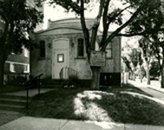
We didn't know what to expect. Would anyone show up? Would the police raid us? Would gay bashers descend on us? We spent the night peeking out
the door to see who was coming. Two big burly construction workers showed up. No one knew them but none of us had the courage to refuse them
entry. We all breathed a sigh of relief when they soon were spotted dancing together on our small dance floor. Approximately 50 people showed
up for that first dance and the police and bashers stayed away.
We approached the Unitarians about renting their hall weekly and they agreed. Our rent was based on how many people showed up so we were guaranteed
not to lose money. We moved the dances to Saturday night even though it meant we had to stay and make sure the hall was clean and ready for worship
the next morning. A small group of us would hustle around Saturdays collecting booze, supplies and a sound system. We would move the pews in
the hall to the outer perimeter, set up a bar, set up the sound system and replace the white light bubs with red and blue one to make the place
look less like a church and more like a club. The process would be reversed in the early morning hours of Sunday.
We became bolder and decided to place an ad in the Star Phoenix which read, Zodiac Friendship Society - an organization for gay men and
women. We began receiving more letters although most of them were from people who said they'd like to join as they were "happy" people.
Usually it fell to me to call them to tell them what we meant by the term gay. Usually they were no longer happy when I told them who we were
for. Eventually we had the ad changed to read homosexual instead of gay, although, the Star Phoenix was reluctant to include the word
homosexual, but after Mavis refused to leave until they agreed to the change they acquiesced.
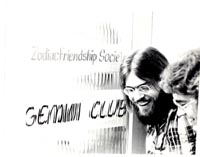
We began drop-ins on Wednesday nights and advertised the Unitarians' phone number for a Gayline available on those nights. We never did tell
the Unitarians that we were advertising their phone number as a Gayline. In a short period of time we were operating two nights a week but it
started to take a toll on people's energy. For a few months we hired a manager to be responsible for getting supplies for the dances and seeing
that things were set up and volunteers in place for our Saturday queer dance club. In November of 1972 Saskatoon hosted a conference of prairie
clubs with representation from queer organizations in Winnipeg, Calgary, Edmonton and Regina attending. Eventually we began to wear down and
dances were put on hold late that year.
Things remained quiet until early in 1973 when we signed a lease for a small space at 224A - 2nd Avenue South. The new centre held it's first
dance March 17. Soon we were operating drop-ins and phone lines on Tuesdays and Wednesdays with a lesbian drop-in on Friday and dances every
Saturday. We were a growing concern.
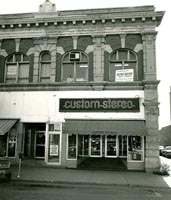
As we began to come out as individuals and as a community the name of Zodiac Friendship Society was changed to the Gay Community Centre and
later to the Gay/Lesbian Community Centre. We wrote briefs to the Saskatchewan Human Rights Commission and Attorney General Roy Romanow calling
for human rights legislation to be changed to include protection against discrimination for gays and lesbians. It took 20 years after the first
brief was presented in 1973 for the government to finally change the Act.
We soon outgrew our facilities on 2nd Avenue and moved to a 6,000 sq ft facility above the Indian and Metis Friendship Centre on 20th Street
between 3rd and 4th Avenues. We were now open 6 nights a week for drop-ins and phone lines and were also running a dance club on Fridays and
Saturdays. All work had been done by volunteers but by 1976 we were such a going concern that I was hired, at minimum wage, to be the first executive
director.
During those years the community grew rapidly as men and women started to emerge from their closets. We were publishing regular newsletters
and providing training for those community groups and professionals courageous enough to want to learn about our issues and needs. We had the
funds to send representatives to national gay conferences which were held inplaces like Ottawa, Toronto, and Winnipeg. In 1977 Saskatoon was
host to the fifth National Gay Conference with representatives from across Canada in attendance.
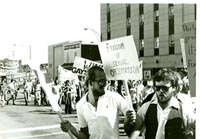
As the community grew so did divisions and in 1977 a major rift occurred over what direction the Community Centre should take. Some of us felt
that we had to become more professional and responsible by having paid staff while other felt the organization could be run entirely by volunteers.
In the fall of 1977 I had had enough of the infighting and resigned as executive director and went to work at Community AID Resource Centre,
Saskatoon's crisis and information line.
The Community Centre moved once again in the late 1970s to a basement space on 3rd Avenue, the current location of the Bassment Jazz Club. As
the decade went on the dance club aspect of the Centre took over and programming around phone lines, coming out groups and other support groups
essentially ceased. The Centre had become a dance club with dances happening two nights a week.
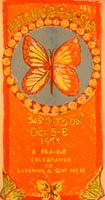
In 1978 a group of people formed Metamorphosis, a weekend of social activities and workshops on various issues. The weekends ended with a huge
Thanksgiving Feast. In the late 1970s another small group felt the need for phonelines and support groups to once again be offered to Saskatoon's
gay and lesbian community. Saskatoon Gay & Lesbian Support Services was formed and began offering a phone line, community library, coming
out groups, a newsletter and other support groups to the queer community.
By the end of the decade a new after hours club, After Dark, opened. It was located on 22nd Street and Avenue B and was managed by a gay man
who had plans to turn it into a commercial gay club. After Dark soon changed from an after hours club to become a regular bar, open regular hours
with liquor service. It changed its name to Numbers and began attracting a regular clientele of gays and lesbians. As the popularity of Numbers
grew fewer and fewer people began attending the dances at the Community Centre.
As the 1970s came to a close Saskatoon had developed a thriving gay and lesbian community. It had diversified and people no longer felt the
same need to work together. It had been a decade of intense highs along with many lows but Saskatoon's queer community had arrived.
Part 1 | Part 2 |
Part 3 | Part 4

